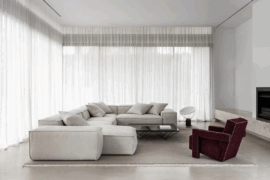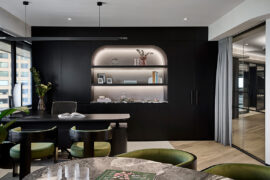Meet Jozef Youssef, the experimental chef of London’s famed Kitchen Theory, who uses science and design to change the way we perceive food.
Jozef Youssef wants to change the way we eat, using the psychology behind the way we experience food to make nutritional, sustainable food more appealing. He left a career as a chef at famed restaurants such as Heston Blumenthal’s The Fat Duck and The Connaught in 2011 to found Kitchen Theory, which he describes as creating engaging, multisensory gastronomy experiences that are driven by research conducted with Professor Charles Spence at Oxford University.
The idea is to translate aspects of the research into nine-course educational dinners, and to find ways to make us want to eat food that’s both good for us and for the environment – think cricket-filled brownies based on the finding that people are more open to entomophagy (the act of eating insects) with sweet, rather than savory, dishes.
“The research is the less flashy part of what we do, but it’s also the most important,” he says. “We test our ideas from the lab on real-life diners at our events. Obviously, we don’t treat them like lab rats, but we do try to collect little amounts of data to confirm research we’re doing in the lab.”
From dishes served with earplugs to surreal plates accompanied by a soundscape, it’s all part of Kitchen Theory’s mission to disrupt the traditional hospitality experience. In doing so, Youssef gives diners an alternative experience that takes them on a journey – and, along the way, teaches them something about how they perceive and understand the act of eating. It’s also a good excuse to play with your food.
Read more about Jozef Youssef and Kitchen Theory in issue #67 of Indesign magazine.
On sale November 17, subscribe here.
INDESIGN is on instagram
Follow @indesignlive
A searchable and comprehensive guide for specifying leading products and their suppliers
Keep up to date with the latest and greatest from our industry BFF's!

How can design empower the individual in a workplace transforming from a place to an activity? Here, Design Director Joel Sampson reveals how prioritising human needs – including agency, privacy, pause and connection – and leveraging responsive spatial solutions like the Herman Miller Bay Work Pod is key to crafting engaging and radically inclusive hybrid environments.

A curated exhibition in Frederiksstaden captures the spirit of Australian design

It’s widely accepted that nature – the original, most accomplished design blueprint – cannot be improved upon. But the exclusive Crypton Leather range proves that it can undoubtedly be enhanced, augmented and extended, signalling a new era of limitless organic materiality.

Architectus disrupts the traditional thinking around public and civic projects with an ‘accessible’ architectural vision for the Christchurch Bus Interchange.

What is interior design’s responsibility in revolutionising aged-care environments? The new Emmy Monash Aged-Care facility in Melbourne’s Caufield has all the luxury commodities of a contemporary multi-residential complex. From thoughtfully considered finishes through to superior shared facilities, no expense has been spared on residents’ comfort and quality of life.
The internet never sleeps! Here's the stuff you might have missed

Harbro has it all – beautiful furniture designs that add a sophisticated touch to any room.

Following the first release of exhibitors, this second instalment brings together another set of brands spanning furniture, finishes, lighting and flooring, confirmed to take part in Melbourne this September.

THISS Studio has completed the interior fit out of a flexible office and creative space in east London for independent communications studio, SALT.

Setting the tone for McCormack’s HQ is Elton Group’s Eveneer WoodWall and Eveneer Raw in Ravenna – wrapping walls, ceilings and bespoke joinery in a dark, matte elegance. The seamless pairing delivers a cohesive, high-performance finish that anchors Studio 103’s luxurious, hotel-inspired workplace design.